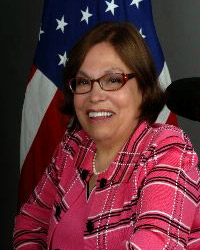 As the 25th anniversary of the Americans with Disabilities Act (ADA) approaches, ACL is featuring guest blogs from leaders in the disability community. In this blog, Judith Heumann, a lifelong civil rights advocate for disadvantaged people and the Special Advisor for International Disability Rights at the U.S. Department of State, reflects on the significance of the intergenerational independent living movement that preceded the passage of the ADA and on the importance of inclusion and integration for all people around the world, regardless of age or disability.
As the 25th anniversary of the Americans with Disabilities Act (ADA) approaches, ACL is featuring guest blogs from leaders in the disability community. In this blog, Judith Heumann, a lifelong civil rights advocate for disadvantaged people and the Special Advisor for International Disability Rights at the U.S. Department of State, reflects on the significance of the intergenerational independent living movement that preceded the passage of the ADA and on the importance of inclusion and integration for all people around the world, regardless of age or disability.
July 26 has the stature of a national holiday for anyone in the disability rights movement. For those of us who are part of the independent living movement, June 22 resonates just as much as the ADA anniversary. On that day in 1999 the Supreme Court rejected the state of Georgia's appeal to enforce institutionalization of individuals with disabilities. The Olmstead decision reinforced Title II of the ADA and affirmed the right of individuals with disabilities to live in their community.
In 1973 when I left Brooklyn, New York, having spent many years as an activist with Disabled in Action, I traveled to Berkeley, California to attend graduate school at UC Berkeley. It was there that I got involved in the development of the first Center for Independent Living (CIL). I was 26 years old and thinking very little about life as an older person with a disability. When I joined the CIL Board, I began to understand that the concept of linking activism with efforts to improve service delivery systems cut across generations.
CILs around the country have shown that thousands of disabled people, who would have been relegated to institutions in the past, can be integrated into society. They can have jobs, have spouses, and have children. Most importantly, older adults and people with disabilities can have a fulfilling life through the provision of peer support and technical assistance. This is not only with regards to people with disabilities; it also holds true that people can have fulfilling lives inside their communities as they age.
The independent living movement is intergenerational and cross-sectional. Advocates for the rights of disabled people of all ages are clearly and consistently stating that we have a right to education, employment, and social inclusion, regardless of our age, and we are not going to let go of our independence and dignity. These are principles that form the foundation of the independent living movement which began in the 1970s, but continues on to this day.
Today at the age of 67, it is very clear that the movement has benefited me and will continue to benefit me and millions of others like me. Those in the independent living movement can say ‘Yes, we did’, but we should also say, ‘there’s more to do.’ This is true not only for ourselves, but for people around the world.
As with all guest contributions to the ACL website, this blog reflects the experiences and thoughts of the author. Find more information about guest content on the ACL site.

